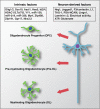Diversity Matters: A Revised Guide to Myelination
- PMID: 26442841
- PMCID: PMC4727993
- DOI: 10.1016/j.tcb.2015.09.002
Diversity Matters: A Revised Guide to Myelination
Abstract
The evolutionary success of the vertebrate nervous system is largely due to a unique structural feature--the myelin sheath, a fatty envelope that surrounds the axons of neurons. By increasing the speed by which electrical signals travel along axons, myelin facilitates neuronal communication between distant regions of the nervous system. We review the cellular and molecular mechanisms that regulate the development of myelin as well as its homeostasis in adulthood. We discuss how finely tuned neuron-oligodendrocyte interactions are central to myelin formation during development and in the adult, and how these interactions can have profound implications for the plasticity of the adult brain. We also speculate how the functional diversity of both neurons and oligodendrocytes may impact on the myelination process in both health and disease.
Keywords: brain plasticity; cerebral cortex; development; myelin; neuron–glia interaction; oligodendrocytes.
Copyright © 2015 Elsevier Ltd. All rights reserved.
Figures



References
-
- Schierbeek A. The collected letters of Antoni van Leeuwenhoek; an appeal to the scientific world. 1953;19(3):181–8. - PubMed
-
- Rosenbluth J. A brief history of myelinated nerve fibers: one hundred and fifty years of controversy. J. Neurocytol. 1999;28:251–262. - PubMed
-
- Virchow R, Chance F. Cellular Pathology as based upon physiological and pathological histology. 1860 Translated from the second edition of the original by F. Chance. - PubMed
-
- Baumann N, Pham-Dinh D. Biology of oligodendrocyte and myelin in the mammalian central nervous system. Physiol. Rev. 2001;81:871–927. - PubMed
-
- Nave KA, Werner HB. Myelination of the nervous system: mechanisms and functions. Annu. Rev. Cell Dev. Biol. 2014;30:503–533. - PubMed
Publication types
MeSH terms
Grants and funding
LinkOut - more resources
Full Text Sources
Other Literature Sources

